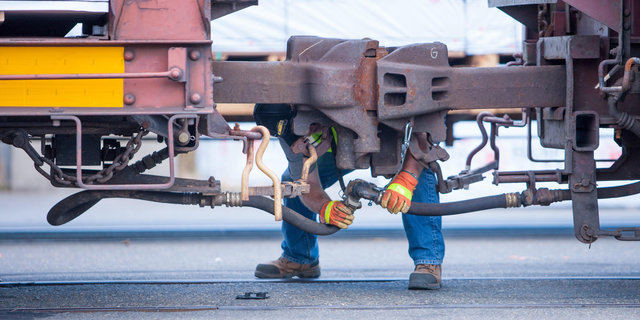
March 8, 2023
Comprehensive Training at the Heart of Rail Safety

From day No. 1, we ensure Team UP has the tools and skills needed to keep the nation’s supply chain moving. Newly hired train crew employees spend up to 14 weeks learning railroad safety and operating basics – including the cycle of a car, from origin to final destination, as well as how to effectively manage critical resources and safely apply rules. To check for understanding, exams are given during the training.
Air Brake and Freight Car Inspection Training Are Critical
One key portion of train crew new hire training involves learning how to properly inspect a car to confirm air brakes are functioning properly and the rail car is free from mechanical defects.
For the hands-on portion of this training, the instructor conducts a Class 1 Initial Terminal Air Brake Test -- after verifying 75 psi on the rear with a handheld gauge or End of Train device, the engineer makes a 20-pound reduction. The students then conduct a safety inspection while rechecking a 100% set of the brakes.
All train crew employees undergo an annual hands-on air brake test, where they must demonstrate they can properly perform a Class 1 Air Brake Test. They also must pass a triennial air brake exam. In addition, Union Pacific’s COMMIT Operational and Testing Program evaluates craft professional’s ability to perform a task in compliance with the rules and procedures under normal operating conditions.
Train crew employees also receive training in train car inspections. Car inspections are required before a train can move. Cars must be checked for:
- Leaning
- Sagging
- Improper position on the truck
- Objects hanging or dragging from the car or extending from the side
- Insecurely attached doors
- Broken or missing safety appliances
- Contents leaking from placarded hazardous material car
- Insecure coupling device
- Overheated wheel or journal
- Broken or cracked wheel
- Brake that fails to release
- Staff type brake not in fully raised position
- Other apparent hazards
In addition, employees receive inspection training to make sure open top loads, including trailers and containers on flat cars, are loaded safely. They’re also taught that if the train’s width or height approaches clearance restrictions, movement must be cleared with the proper authority.
Employees are instructed that a freight car with any defect that makes movement unsafe must be corrected or set out of the train. When a defect is discovered en route, employees are trained to note the type of defect on a proper tag and attach the tag on each side of the car.
Training Commitment Goes Beyond the Basics
Union Pacific’s training standards meet Federal Railroad Administration (FRA) guidelines that requires all transportation craft professionals undergo the type of safety training described above and receive periodic refresher training.
We recognize our employees are unique individuals whose needs evolve as they grow in their careers with us. Our training centers around their development, providing resources and support to meet them at every stage of their journey – from honing current skills and building leadership qualities to preparing them to take the next step in their journey. In 2022, we averaged nearly 47 hours of training per employee – a 62% year-over-year increase due to our robust hiring efforts.
To help our craft professionals grow their skill sets and become experts in their craft, we offer a wide variety of skill enhancement courses. In 2022, team members completed about 10,000 courses on topics such as CPR, welding, ballast tamping, track inspection and locomotive maintenance. Students learn how to correctly maintain equipment, as well as demonstrate proper techniques while completing common railroad work practices.